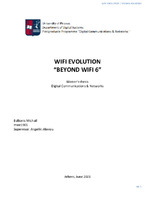WIFI evolution “beyond WIFI 6”

Master Thesis
Συγγραφέας
Μπαλκώνης, Μιχαήλ
Balkonis, Michail
Ημερομηνία
2021-06Επιβλέπων
Αλεξίου, ΑγγελικήAlexiou, Angeliki
Προβολή/
Περίληψη
Αντικείμενο της παρούσας Διπλωματικής Εργασίας είναι η εξέλιξη του προτύπου WLAN 802.11 γνωστό και ως WIFI. Η παρούσα μεταπτυχιακή εργασία έχει ως σκοπό την αναφορά και ανάλυση του προτύπου 802.11be καθώς και των χαρακτηριστικών του WIFI 6 ή 802.11ax πάνω στα οποία θα βασιστεί η ανάπτυξη και η εξέλιξη του WIFI 7.
Θα αναλυθούν χαρακτηριστικά του WIFI 6 καθώς τα στάνταρντ οι στόχοι και μελλοντικές εξελίξεις που θα επιφέρει το WIFI 7 (802.11be) ή αλλιώς Extremely High Throughput στην κοινωνία μας.
Στο 1ο κεφάλαιο γίνεται μια γενική εισαγωγή στα ασύρματα δίκτυα. Εξηγούμε τι είναι τα ασύρματα δίκτυα, που μας χρειάζονται, καθώς πραγματοποιείται και μια ιστορική αναδρομή. Συνεχίζοντας επισημαίνεται η βασική αρχιτεκτονική του WLAN 802.11 με τα στοιχεία που χρησιμοποιούνται στα ασύρματα δίκτυα. Πραγματοποιείται μια αναφορά στις προδιάγραφες των στάνταρ του 802.11. Καθώς τέλος αναλύεται τόσο το Physical όσο και το MAC στρώμα.
Στο 2ο κεφάλαιο γίνεται μια εκτενέστερη επισκόπηση στο πρότυπο 802.11ax, αναλύονται τα νέα χαρακτηριστικά καθώς και οι σχεδιαστικοί στόχοι. Στη συνέχεια πραγματοποιείται μια επισκόπηση φυσικών βελτιώσεων του προτύπου 802.11ax. Ολοκληρώνοντας το κεφάλαιο αναφέρονται οι περιπτώσεις χρήσης καθώς και τα πλεονεκτήματα ,μειονεκτήματα του προτύπου 802.11ax.
Το 3ο κεφάλαιο αναφέρεται στο μελλοντικό WI-Fi και συγκεκριμένα η επέκταση του Wi-Fi 6 στη μπάντα των 6GΗz με την σημαντικότητα της και της αλλαγές τις οποίες θα επιφέρει. Αναφέρονται τα πλεονεκτήματα της αναβάθμισης αυτής καθώςς και τις προκλήσεις που θα επιφέρει η εξέλιξη αυτή.
Στο 4ο κεφάλαιο κάνουμε αναφορά στο μελλοντικό WIFI 7 και συγκεκριμένα με την ονομασία του Extremely High Throughput , IEEE 802.11be. Στο κεφάλαιο αυτό θα μελετηθεί το χρονοδιάγραμμα ανάπτυξης του όπως αυτό ορίζεται από την WIFI κοινότητα καθώς και τις ημερομηνίες κυκλοφορίας των χαρακτηριστικών του.
Θα αναλυθούν τα χαρακτηριστικά που επρόκειτο να εισαχθούν στη νέα τεχνολογία τόσο στο φυσικό στρώμα όσο και στο στρώμα της MAC.
Στη Συνέχεια στο κεφάλαιο 5 θα γίνει μια εκτενέστερη αναφορά σε ένα βασικό χαρακτηριστικό που θα έχει βασική θέση στις μελλοντικές εξελίξεις , αυτό είναι Time Sensitive Network (TSN) του 802.11be, καθώς και τις βελτιώσεις τις οποίες θα επιφέρει. Επιπροσθέτως αναλύονται οι τομείς και τις περιπτώσεις χρήσης στη κοινωνία μας το χαρακτηριστικό του TSN. Κλείνοντας θα παρουσιαστούν καποια Simulations και τα αποτελέσματα αυτών.


